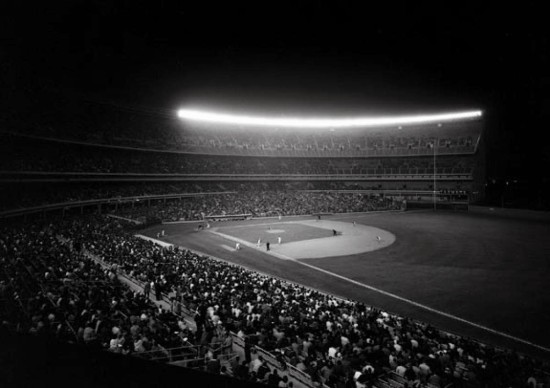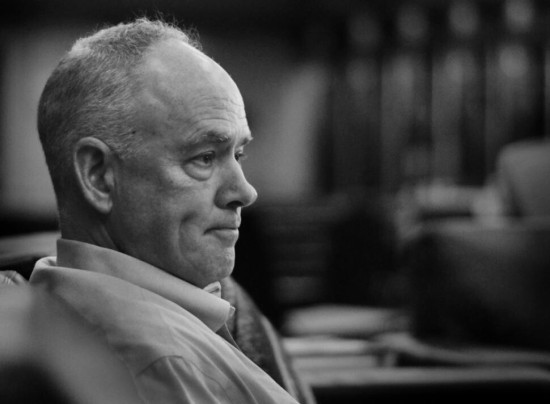
My coming of age as a Mets fan evolved, as it were … When I was young I had no idea why the Mets might be good or bad or mediocre. As I got older, unlike my Dad who was preoccupied strictly with events on the field, I began to be aware of problems with ownership and management, particularly after the death of the venerable Joan Payson.
M. Donald Grant and his antipathy towards free agency at its advent was a harbinger of dark and contentious times. The team declined steadily in the late 70’s and I was familiar enough with Met management’s opprobrious denial of labor developments to know it was at least partially the result of an outmoded approach, particularly after the infamous bloodbath of June, 1977.
It would be what seemed like innumerable last place finishes before any break in the clouds would be seen. In1980 the Mets were purchased by Doubleday Inc., spearheaded by the charismatic and personable Nelson Doubleday.
In recent years there has been this alternate version of events advanced that seem to imply that the prime mover in this sale was none other than Fred Wilpon, who was apparently instrumental in coalescing an ownership group that included City Investing Co., Doubleday, and Mr. Wilpon himself.
Doubleday nevertheless became chairman of the Mets board with a 50% stake owned by Doubleday Inc. As a fan in the 1980’s, I had no idea who Fred Wilpon was. Perhaps it was my youth and my tendency to skim through the sports pages, but this notion that it was Wilpon who “rescued” the Mets from the lost and adrift malaise of the late 70’s seems like a historical revision.
Regardless of who made the calls and how the the right people came to the table, it was Doubleday who put up the lion’s share of the cash and if any of us young Mets fans back then remember a perceived savior, it was Doubleday. I remember telling my dad about this great great nephew of the man who invented baseball. I don’t remember anything about no Bensonhurst buddy of Sandy Koufax from Lafeyette H.S.
But Wilpon was there. Lurking in the boardrooms and bowels of old Shea, Fred Wilpon managed to parlay his 1% ownership into a role as Chief Executive Officer from 1980 well into his years as partner.
Doubleday knew the ropes when it came to making things happen in N.Y. He’d been raised a blueblood and was groomed to join with elite and powerful company from a young age. He was one of the primary reasons traditionalist Bowie Kuhn was ousted from his position as Commissioner of Baseball a mere two years after Doubleday became owner of the Mets.
Kuhn had failed to appease owners who wanted new and innovative changes, a byline for their desire to make truckloads of cash from a changing tele-media landscape. So in a real sense, it was Doubleday who represented the Mets at the ownership table in the early 80’s, not Wilpon.

Wilpon was something of an upstart in the big moneyed country club set, and while he was rich, he was never insanely rich. He managed to make a great deal of money by accident if you will, purchasing a myriad assortment of properties as tax write-offs in the lead up to what became one of the biggest housing booms in U.S. history. This made him a very wealthy man. By 1980 he found himself in a position to purchase 1% of the N.Y. Mets. By 1986 things for the WIlpons had apparently taken an even greater turn for the better.
Fred WIlpon utilized his right of first refusal, a clause slipped into his initial 1% purchase which stipulated that if Doubleday Inc. were to attempt to sell the team Wilpon would be allowed first dibs on a purchase offer. Wilpon was able to elbow his way into a 50/50 split even though Doubleday was essentially attempting to sell the team to himself. Well not quite — he was selling Doubleday Co. (who owned the Mets) but wished to hold onto the Mets.
I got wind of this uncomfortable partnership through the euphoria of our first championship since 1969, worried that a good thing might perhaps get muddled, little did I know how justified those concerns were. How the Wilpons managed to go from barely able to scrape together enough for a 1% purchase in 1980 to the considerable advance needed to make a 50% bid in 1986? That’s a tale best left for another day and another entry, lets leave it as a conspicuous rise in fortunes.
The lead up to 1986 was a strange time. I remember George Bamberger quitting on a 1983 team featuring George Foster (signed to a 10 million dollar contract), Hubie Brooks at third, Mookie Wilson in center, Jose Oquendo at short, and a young somewhat overmatched but wildly promising slugger named Daryl Strawberry.
But the team was interesting in spite of the fact that the Mets hadn’t finished with a .500 record (or higher than fifth) since 1976. It was interesting because Doubleday hired a baseball insider named Frank Cashen who not only spent on free agents, but on hometown favorites like Dave Kingman, returning the “franchise” Tom Seaver, to Queens. All the while Cashen was quietly fortifying a farm system that would be instrumental in returning the team to glory.
Foster and Seaver were little more than diversions from the real work of rebuilding the organization. I eventually came to see that this was the genius of Frank Cashen. He knew the overhaul would take years and that New Yorkers were impatient. Foster, Kingman, and Seaver were smokescreens meant to keep the fans interested. Cashen had full autonomy back then. He had the authority to spend even when spending amounted to little more than a diversion from his real task — orchestrating a build up to the critical mass of talent that hit the stage in 1985 and 1986.
Cashen was able to do this because he had complete control and because ownership prior to 1986 had the wherewithal to stay out of the picture and let the baseball people do their thing.
What does all this have to do with our current Mets?

When Sandy Alderson was hired in 2011 it was not only closely on the heels of a Madoff scandal that was threatening to bring down Mets ownership, there were also numerous indicia that the hire was endorsed if not orchestrated by Bud Selig.
Now I’ve never had much faith in the Wilpons as far as their competence in running a Major League franchise, but while I’ve had issues with Bud Selig I don’t think incompetence has ever been one of them. Bud has always been aware of his bottom line, cultivating revenue streams Baseball couldn’t dream of back in the 80’s. I hate to say it, but it was almost reassuring that this new Mets GM was all but sanctioned by the shrewd and somewhat ruthless Selig.
Selig knew the Mets would be in need of a major financial overhaul if current ownership was to somehow survive the tumultuous aftermath of the Madoff debacle. Selig’s influence may even now be understated given the emergency bridge loan floated to the Mets right around the time of Alderson’s hire and the fact that it was well within Selig’s power to relieve the Wilpons of their ownership if he had a mind to.
This guy Alderson was about as close to being appointed by MLB as you could get without actually being appointed by MLB. You’ll all recall that Alderson’s previous stint was cleaning up a cesspool in the Dominican Republic talent pipeline which was rife with drugs, rogue sports agents, identity fraud and age fraud. Alderson had the ring of a “clean up” man … that guy who makes problems go away. A Marine, a Vietnam war veteran and a Harvard grad, Alderson didn’t strike me as someone Jeff Wilpon would be barking at any time soon.
And that was a very good development.
Alderson hired two former General Managers to run his baseball operations. Paul Depotesta and J.P. RIcciardi. They handled baseball while he oversaw an organizational overhaul focusing on cohesion of purpose and doctrine across all levels and departments. There is no doubt in my mind that there was little if any interference from Jeff Wilpon or any other ownership representative during these years. Their input was limited to setting a budget, and boy was it limited.
It was an odd and painful bargain. The same disaster that forced a General Manager on the Mets who would resist interference, strangled the team’s finances, reducing them to a bottom third payroll. As a fan all I could think about was the years from 1980 to 1984 when the fans were just as impatient and the team was just as bad. Fans of recent years haven’t even had the benefit of table scrap entertainment purchases like Seaver and Kingman. It’s been a dreary slog to be sure.
But In the end the signs are all there. The farm is arguably positioned better than the Mets farm was back in 1985. It is certainly deeper than what we had during the Generation “K” years, and, much like what we saw in 1985, we are already seeing some returns on our talent. As much as the fans clamored for trades these past couple of years, this management group, to the delight of purists everywhere, has resisted trading prospects, focusing laser-like on stockpiling an impressive collection of minor league talent.

The rebuild was orchestrated by Sandy Alderson because he was given a window of autonomy opened in the chaos of a ponzi scheme, and he took it. Running his rebuild with impunity, indifference, and a mastery of double-talk that would make a ventriloquist’s head spin, Alderson placated the media, confounded his critics, and condescended to his so-called benefactors with remarkable aplomb while his brainy minions focused on the real work.
Lacking the financial flexibility to run interference with an occasional splash (Cano would have been nice), Alderson simply turned down the static and rebuilt the team the only proven way teams have consistently reconstituted in modern history, from the farm up, drafting, developing, and retaining talent.
That he was able to do this under current ownership and in New York no less, is nothing short of astonishing.
I would be surprised if the Mets do not contend in the near future. The Mets minor leagues are winning at a higher rate than any other organization in the game. These kids are beating up on the kids of virtually every other system out there. We need to consider that prospects who come up playing for teams like the Orioles and the Cubs and the Dodgers know these Mets affiliates to be pitching heavy powerhouses … this contagion of arms has to bleed up to the major league level at some point.
I have to believe that under the circumstances it’s only a matter of time before the remarkable patience of Mets fans is rewarded. I have to. Baseball wouldn’t make sense if that weren’t the case … Baseball is, after all, still a young man’s game, and pitching … pitching wins championships.















